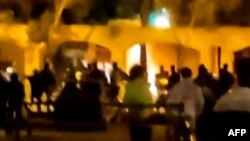Reports on social media Friday showed protesters in western Iran setting fire to the ancestral home of Islamic Republic founder Ayatollah Ruhollah Khomeini.
Video posted to social media showed the house on fire as crowds marched past and cheered late Thursday in the town of Khomein, where the late ayatollah was born in the western province of Markazi.
The state-run semi-official Tasnim news agency – affiliated with the Islamic Revolutionary Guard Corps – denied the reports, saying the home – which had been converted to a museum – was still open.
Both Reuters and the French news agency AFP verified the authenticity of the video, though they could not determine the date it was taken. It is also unclear how badly the fire damaged the home.
On his Twitter account, journalist and author David Patrikarakos, who has written a book on Iran's nuclear ambitions, re-tweeted pictures from the scene and wrote the fire represents an "attack" challenging "the essence of the republic itself."
The home is where Ayatollah Ruhollah Khomeini was born. His surname was taken from the town of Khomein. In the 1970s, he lived in exile in Paris, where as a cleric, he was a harsh critic of Iran's then leader, the U.S.-supported shah, Mohammad Reza Pahlavi.
Khomeini returned to Iran in 1979 to lead the Islamic revolution in the country.
Ongoing nationwide protests in Iran began in response to the September 16 death of 22-year-old Iranian Mahsa Amini while in police custody. Iran’s morality police had arrested Amini days earlier for allegedly not covering her hair fully enough with a hijab.
Iran’s Islamist rulers long have demanded that women cover their hair in public in accordance with strict dress codes.
The protests against Amini’s death quickly evolved into a broader call by many Iranians for freedom and leadership change. During the protests images and other depictions of Khomeini have been destroyed or defaced by protesters.
Some information for this report was provided by Reuters and Agence France-Presse.












